Table of contents
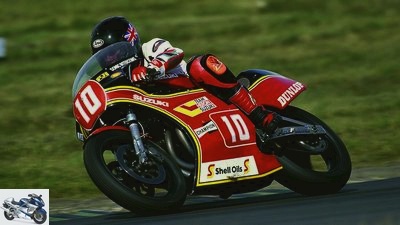
Nakamura
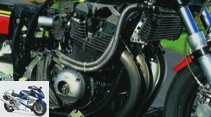
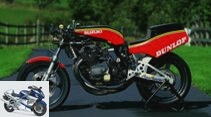
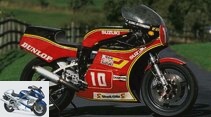
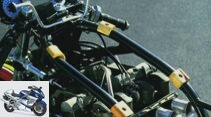
7th pictures
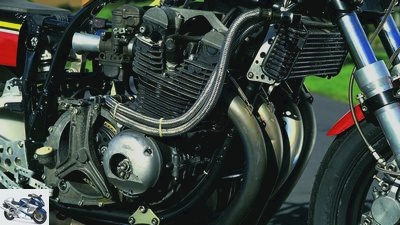
Nakamura
1/7
The TT Formula 1 regulations allowed the Suzuki XR69 to deviate more from the production motorcycle than with the AMA superbikes: larger valves with more stroke and sharper valve timing, forged pistons, light bucket tappets, a reinforced crankshaft and stiffer connecting rods did not leave the innards of the original four-cylinder engine more a lot left.
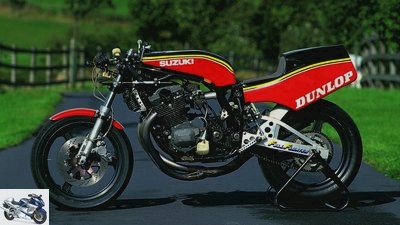
Nakamura
2/7
1440 millimeters of wheelbase guarantee driving stability and expect a down-to-earth front wheel.
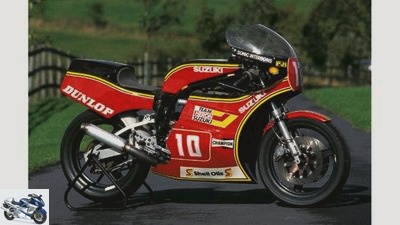
Kyoichi Nakamura
3/7
The basic layout of the Suzuki XR69 corresponds to the contemporary 1000 cc four-cylinder four-stroke engines. However, various details reveal a close relationship to Barry Sheene’s 500cc GP motorcycle, from which she took over chassis components and brakes.
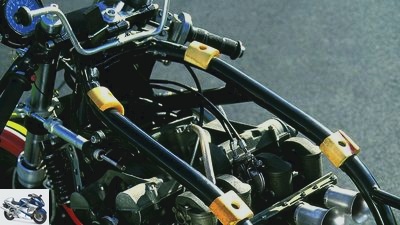
Nakamura
4/7
The idle gas levels off at 3000 rpm, even without a choke, and the high-torque engine pulls through confidently from 3500 rpm, as long as you don’t overtax it with a tight throttle cable too early. Nowadays electronically controlled components would do the mixture metering, at that time the driver’s right wrist played the central role in this task.

Nakamura
5/7
The aerodynamically shaped fairing dome encompasses the driver extensively and offers very good wind protection, which is an advantage that should not be underestimated in long races.

Nakamura
6/7
The Kayaba telescopic fork with 40 mm stanchions offered 130 millimeters of suspension travel and – clearly seen here – an anti-dive system.
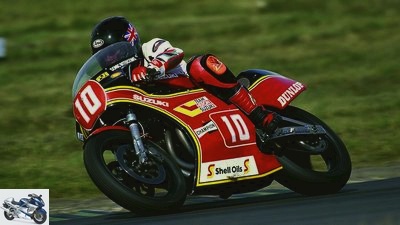
Nakamura
7/7
In terms of performance and weight, the XR69-S plays in the league of modern 600 super sports cars. On the slopes, however, it quickly shows that it comes from a different era: It is a large motorcycle in every respect and gives the driver a lot of space.
motorcycles
classic
Suzuki XR69-S
Suzuki XR69-S
The first racing motorcycle with a central shock absorber
Content of
The Suzuki XR69-S spans two eras: its engine represents an era that ended around 1980; their chassis with central spring strut opened up the modern age.
Alan Cathcart
07/08/2010
Groundbreaking innovations are often subject to the following life cycle: First everyone who is not involved declares the inventor to be crazy, then the supposedly absurd construct proves its worth. As a result, of course, everyone has always been convinced of it and copied the innovation. A little later she looks so obviously brilliant that no one appreciates the courage that the first step cost.
One such innovation in the early 1980s was the abandonment of two spring struts hinged directly to the swing arm and the move towards a progressively working central spring strut, which the Suzuki GS 1000 R XR69-S carried out in 1981. Suzuki GS 1000 offshoots modified by Pops Yoshimura’s knowledgeable hand had already won the Daytona 100-mile races in 1978, 1979, 1980 and 1981 and clinched two AMA Superbike titles. The potential of the motorcycle encouraged the European importers, with Yoshimura’s support in the endurance world championship and the TT Formula 1, to dare to attack the overwhelming forces of Honda.
Compared to the AMA Superbikes, the TT Formula 1 regulations allowed greater deviations from the production motorcycle: Larger valves with more lift and sharper timing, forged pistons, light bucket tappets, a reinforced crankshaft and stiffer connecting rods left little of the innards of the original four-cylinder engine. The engine turned out to be so powerful that the gear ratios did not have to be adjusted apart from a longer geared first gear; the oil bath clutch, however, received stiffer springs and racing pads. The air-cooled engine with two overhead camshafts and two valves per cylinder released up to 132 hp at a dry weight of 159 kg. To get the temperature under control, the team prepared the engine with thermal paint, the rough surface of which was better at radiating the heat.
The basic layout of the Suzuki XR69 corresponds to the contemporary 1000 cc four-cylinder four-stroke engines. Various details, however, reveal a close relationship to Barry Sheene’s 500cc GP motorcycle, from which it took over chassis components and brakes: The Kayaba telescopic fork with 40 mm stanchions offered 130 millimeters of travel and an anti-dive system. First, a box swing arm made of light metal with a stiffening girder and two spring struts was used. The progressively working central spring strut and the swing arm with upper pull only received the version XR69-S, which was revised for the 1981 season. Two-piston fixed calipers with delayed front wheel and 310 mm diameter steel discs; A single-piston floating caliper and a 220 washer worked at the rear.
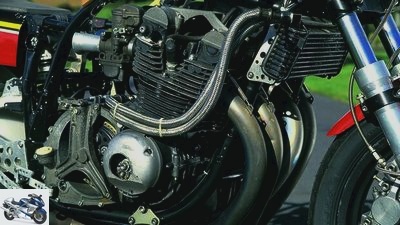
Nakamura
In contrast to the series engine, the racing engine had a dry clutch.
In 1980, Jean-Bernard Peyre and Fabien Gibol contested the first race with the XR69: They sensationally finished the 24 Hours of Le Mans in second place. The prestigious Bol d’Or at the end of the endurance season even saw two XR69s under Pierre-Etienne Samin / Franck Gross and Jean Monnin / Gary Green in first and second place.
In England, Graeme Crosby led the Suzuki to second place behind Mick Grant’s Honda on its TT F1 debut on the Isle of Man. He won the only other TT F1 round of the season, the Ulster GP, ahead of his teammate Joey Dunlop, which gave him and the Suzuki the title that the FIM had awarded world championship status. In 1981, Crosby dominated the British TT F1 series, winning six times in nine races and securing the national championship, although Suzuki decided not to use the new four-valve engine from the GSX 1000. In 1982, Crosby moved up to the premier class of the Grand Prix with Suzuki, and former Honda rival Mick Grant took his place on the XR69-S. He achieved the British title hat trick in the national TT-F1, MCN Superbike and ACU British Road Racing series.
In the endurance world championship in 1983, the Suzuki won the title it deserved in HB colors under the Frenchman Herve Moineau and the Belgian Richard Hubin. In the same year, the newcomer Rob McElnea finished the British TT-F1 and the F1 World Championship with the Suzuki in second place. He also achieved the last victory of the XR69, namely in 1984 at the Classic TT on the Isle of Man.
In terms of performance and weight, the XR69-S, which today can sniff fresh air on the short but fast Snetterton course, plays in the league of modern 600 super athletes. On the slopes, however, it quickly shows that it comes from a different era: It is a large motorcycle in every respect and gives the driver a lot of space; the ergonomic requirements speak for hanging-off and knee loops. The aerodynamically shaped fairing dome encompasses the driver extensively and offers very good wind protection, which is an advantage not to be underestimated in long races. A wheelbase of 1440 millimeters means driving stability and a down-to-earth front wheel can be expected.
The idle gas levels off at 3000 rpm, even without a choke, and the high-torque engine pulls through confidently from 3500 rpm, as long as you don’t overtax it with a tight throttle cable too early. Nowadays electronically controlled components would do the mixture metering, at that time the driver’s right wrist played the central role in this task. The strongest phase of the four-cylinder is between 5500 and 6800 rpm; then it allows full throttle up to the engine speed limit. In racing, the Suzuki turned up to 10,500 rpm if the driver wanted to save two gear changes between two corners. “Apart from that, there was no need to go higher than 9500,” confirms Mick Grant. Rather, the recipe for fast laps is to sort the five courses early and vigorously and to trust the broad front of newton meters. The right-hand gearbox makes no secret of when a gear is engaged, otherwise there would only be a ball of valve stems in the cylinder head.
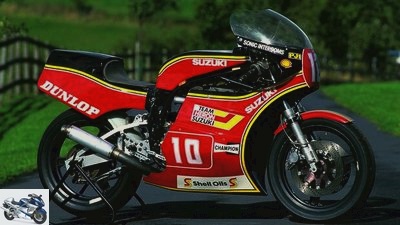
Nakamura
Mick Grant’s example in British Heron livery looks quite massive when stationary – and even more so when it comes to driving.
Curves are a very special story on the XR69-S: When braking, the high idle speed makes you believe that the throttle slides are not properly closed. The largely successful attempt to avoid rear wheel punches even without an anti-hopping clutch when downshifting is paid for by the driver by being frightened to see the first turning points swipe past under him. Once he has internalized the correct timing of the accelerator and brake, the next challenge is similar to trying to dance the Viennese waltz with a freestyle wrestler: the four-cylinder is mounted high up in the chassis for the benefit of freedom from banking. Unfortunately, the developers forgot to fix the center of gravity on the girder of the double loop frame, so that it also wandered far upwards and demands heavy effort when turning in: It goes into the curve with a bang. Harassment has something to do with it “harass” to do, every change of lean angle makes that clear. It is not for nothing that the handlebar ends are exposed: the rider’s power is much greater when he creates with the lever. The fact that the XR69-S pushes a little over the front wheel during such maneuvers hardly matters.
Suzuki knew these difficulties: the triple clamped triple clamps were available with different offset values, and Mick Grant allegedly spent a lot of training time trying to find the optimal constellation for each route. This was all the more important because the fork gives the rider comparatively little feedback when braking. After all, the narrow 18-inch tire at the front is very user-friendly when braking into bends and is almost free of pitching moments.
The spring / damper elements feel highly trustworthy even by today’s standards: the fork sustainably eliminates waves of asphalt pushed together by cars, even at high speeds and in an inclined position. The progressive linkage of the swing arm allows a stable middle ground between fine response, high bottom-through reserves and limited spring travel.
Perhaps it is a little too far-reaching, but the idea of not radically exhausting the technology, but rather looking for the best compromise with the driver in mind, is what makes racing motorcycles successful today. And that was by no means always as natural as one would like to believe in retrospect.
Related articles
-
Big bikes from Honda, Suzuki, Kawasaki and Yamaha
archive counselor Used purchase Big bikes from Honda, Suzuki, Kawasaki and Yamaha Buying advice: big bikes The big bike generation from 1984 Content of…
-
Honda CBF 600 S, Suzuki Bandit 650 S, Kawasaki ER-6f, Suzuki SV 650 S
Artist 18th pictures Honda 1/18 Honda 2/18 Honda 3/18 Honda 4/18 Honda 5/18 Honda 6/18 Honda 7/18 Honda 8/18 Honda 9/18 Honda 10/18 Honda 11/18 Honda…
-
Driving report Suzuki GSX-R 600 (2008)
Suzuki motorcycles Super athlete Driving report Suzuki GSX-R 600 (2008) Driving report Suzuki GSX-R 600 (2008) Gixxer with a new swing The new GSX-R 600…
-
Middle class bikes from Yamaha, Kawasaki, Suzuki and Honda
fact 27 pictures fact 1/27 Comparison of mid-range motorcycles from Yamaha XJ6 Diversion F, Kawasaki ER-6f, Suzuki GSX 650 F and Honda CBF 600 S. fact…
-
Second hand advice Suzuki GS 500 E
Holzwarth counselor Used purchase Second hand advice Suzuki GS 500 E Second hand advice Suzuki GS 500 E Price plunge The Suzuki GS 500 E has been one of…
-
fact accesories Optimization Suzuki SV 1000 S Optimization Suzuki SV 1000 S Craft lesson Runs and runs and runs ?? the tried and tested Suzuki twin…
-
On the move: 250cc from Kawasaki, Suzuki and Yamaha
Jahn 45 pictures Jahn 1/45 Jahn 2/45 Reminisce: For many, a 250cc two-stroke was the first real motorcycle in the 70s. Jahn 3/45 Jahn 4/45 Jahn 5/45 Jahn…
-
motorcycles Top test Suzuki SV 1000 S Top test Suzuki SV 1000 S light on the horizon Anyone who knows the Japanese knows how much they take criticism to…
-
Comparison test between Suzuki DL 1000 V-Strom and Yamaha TDM 900
Artist motorcycles Comparison test between Suzuki DL 1000 V-Strom and Yamaha TDM 900 Comparison test between Suzuki DL 1000 V-Strom and Yamaha TDM 900…
-
Comparison test: Honda Hornet, Kawasaki Z 750, Suzuki GSR 600
Jahn motorcycles Comparison test: Honda Hornet, Kawasaki Z 750, Suzuki GSR 600 Comparison test: Honda Hornet, Kawasaki Z 750, Suzuki GSR 600 ABS shooters…